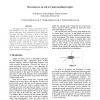Free Online Productivity Tools
i2Speak
i2Symbol
i2OCR
iTex2Img
iWeb2Print
iWeb2Shot
i2Type
iPdf2Split
iPdf2Merge
i2Bopomofo
i2Arabic
i2Style
i2Image
i2PDF
iLatex2Rtf
Sci2ools
IV
2003
IEEE
2003
IEEE
Movement as an Aid to Understanding Graphs
This paper describes a graph visualization method that attempts to aid the understanding of graphs by adding continuous local movement to graph diagrams. The paper includes a discussion of some of the many different kinds of potential graph movement and then describes an empirical trial that was conducted to investigate whether one kind of movement helps with a particular graph comprehension task. Although the results of the trial are promising, the degree of benefit afforded by the movement varies between graphs and the paper includes a discussion about graph features which may account for this discrepancy.
Continuous Local Movement | Graph Visualization Method | Information Technology | IV 2003 | Potential Graph Movement |
| Added | 04 Jul 2010 |
| Updated | 04 Jul 2010 |
| Type | Conference |
| Year | 2003 |
| Where | IV |
| Authors | John Bovey, Peter Rodgers, Florence Benoy |
Comments (0)

